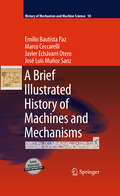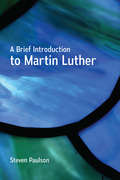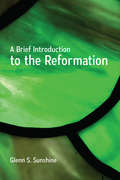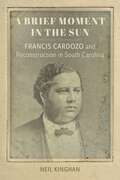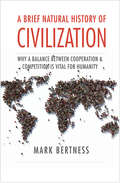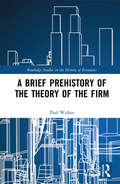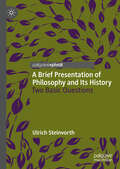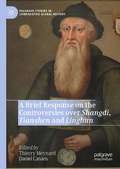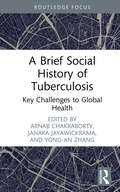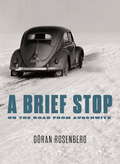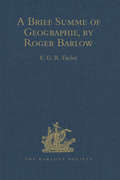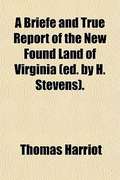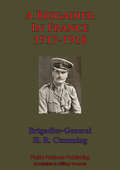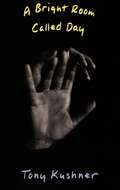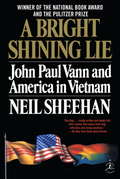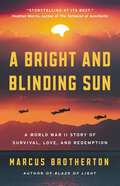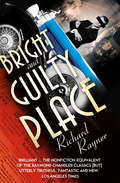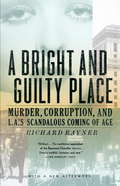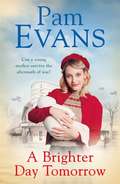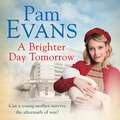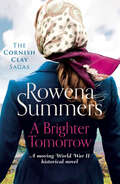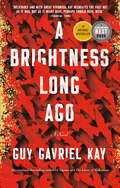- Table View
- List View
A Brief Illustrated History of Machines and Mechanisms (History of Mechanism and Machine Science #10)
by Marco Ceccarelli Emilio Bautista Paz Javier Echávarri Otero José Luis Muñoz SanzThis work deals with mechanical manufacturing processes in history, examined through the machines associated with those processes. A tool is only included if it is part of a machine tool, with devices made up of moving parts. Once the analytical field has been marked out, the chosen descriptive method is basically graphic. This historical compendium attempts to give a wide-angle view of historical development without making an in-depth analysis of each of the examples presented. Moreover, this book illustrates the historical development of machines and mechanisms more from a technical point of view rather than a strictly history of science point of view since the authors are mechanical engineers who are interested and motivated to examine the most significant facts in their own area of knowledge of the Theory of Machines and Mechanisms. A full understanding of the historical development of Technology also needs the help of experts in technical matters who can appreciate and reassess bygone achievements in the light of their own technical knowledge. More collaboration between science historians and technical experts is needed, as is currently the case in the field of Industrial Archaeology. Thus, this book is also an attempt to set out a technical approach to the historical development of machines and mechanisms, but without too many technical details that will prevent its understanding being purely historical. At the beginning of each chapter there is a global reference to the period embraced, the most relevant facts, and the most significant treatises in the context of machine history. Following this introduction each chapter contains a series of sections on the types of machines that are representative of the period analysed together with illustrations to accompany the text. A fairly extensive bibliography enables the reader to make a deeper historical analysis.
A Brief Introduction to Martin Luther
by Steven PaulsonIn the sixteenth century, Martin Luther started a reformation movement that revolutionized Europe and the history of the Christian faith. His far-reaching reforms of theological understanding and church practices dramatically changed both church and society in Europe and beyond. In honor of the 500th anniversary of the Reformation, Steven Paulson provides an engaging, concise introduction to Martin Luther's life and the major themes in his theology.
A Brief Introduction to the Reformation
by Glenn S. SunshineThis readable, accessible introduction provides a solid grounding in the history of the Protestant Reformation. In honor of the 500th anniversary of the Reformation, Glenn Sunshine examines the key people and ideas of this movement. Questions for discussion and suggestions for further reading provided for each chapter make this book ideal for the classroom or group study.
A Brief Moment in the Sun: Francis Cardozo and Reconstruction in South Carolina
by Neil KinghanWinner of the George C. Rogers Jr. Book AwardA Brief Moment in the Sun is the first scholarly biography of Francis Lewis Cardozo, one of the most talented and influential African Americans to hold elected office in the South between Reconstruction and the civil rights era. Born to a formerly enslaved African American mother and white Jewish father in antebellum South Carolina, Cardozo led a life of extraordinary achievement as a pioneering educator, politician, and government official. However, today he is largely unknown in South Carolina and among students of nineteenth-century American history.Immediately after the Civil War, Cardozo succeeded in creating and leading a successful school for formerly enslaved children in the face of widespread racial hostility. Between 1868 and 1877, voters elected him secretary of state and state treasurer. In the Republican administrations that controlled the state during Reconstruction, Cardozo was a famously honest officeholder when many of his colleagues were notoriously corrupt. He played a major part in securing a viable educational system for Black and white children and land reform for thousands of landless families. Cardozo proved that Black men could govern at least as well as white. As a result, he became the target of white supremacist Democratic politicians after they reclaimed power through a campaign of violence and intimidation. They prosecuted, convicted, and imprisoned Cardozo on a fabricated fraud charge. Pardoned in 1879, Cardozo moved to Washington DC, where he led an even more successful school for African American children.Neil Kinghan’s Brief Moment in the Sun is the first complete historical analysis of Francis Cardozo and his contribution to Reconstruction and African American history. It draws on original research on Cardozo’s early life and education in Scotland and England and pulls together for the first time the extant sources on his experiences in South Carolina and Washington, DC. Kinghan reveals all that Cardozo achieved as a Black educator and political leader and explores what else he might have realized if white racism and violence had not ended his efforts in South Carolina. Above all, Kinghan shows that Francis Cardozo deserves a place of honor and distinction in the history of nineteenth-century America.
A Brief Natural History of Civilization: Why a Balance Between Cooperation and Competition Is Vital to Humanity
by Mark BertnessA compelling evolutionary narrative that reveals how human civilization follows the same ecological rules that shape all life on Earth Offering a bold new understanding of who we are, where we came from, and where we are going, noted ecologist Mark Bertness argues that human beings and their civilization are the products of the same self-organization, evolutionary adaptation, and natural selection processes that have created all other life on Earth. Bertness follows the evolutionary process from the primordial soup of two billion years ago through today, exploring the ways opposing forces of competition and cooperation have led to current assemblages of people, animals, and plants. Bertness’s thoughtful examination of human history from the perspective of natural history provides new insights about why and how civilization developed as it has and explores how humans, as a species, might have to consciously overrule our evolutionary drivers to survive future challenges.
A Brief Prehistory of the Theory of the Firm (Routledge Studies in the History of Economics)
by Paul WalkerThe theory of the firm did not exist, in any serious manner, until around 1970. Only then did the current theory of the firm literature begin to emerge, based largely upon the work of Ronald Coase and to a lesser degree Frank Knight. It was work by Armen Alchian, Robert Crawford, Harold Demsetz, Michael Jensen, Benjamin Klein, William Meckling and Oliver Williamson, among others, that drove the upswing in interest in the firm among mainstream economists. This accessible book provides a valuable overview of the ‘prehistory’ of the firm. Spanning an impressive timeline, it delves into Antiquity, the Medieval era, the pre-classical economics period and the 19th and 20th centuries. Next, the book traces the theoretical contributions from pre-classical, classical and neoclassical economics. It will be illuminating reading for students and researchers of the history of economic thought, industrial organization, microeconomic theory and business history.
A Brief Presentation of Philosophy and Its History: Two Basic Questions
by Ulrich SteinvorthThis book presents philosophy as a historical series of answers to two questions: the meaning question (what does it all mean?) and the reality question (what is real rather than illusory?). Presenting philosophy as a historical series of answers to these two questions gives a new view of philosophy. It reveals a coherence between the disparate problems of philosophy which is not apparent when philosophy is approached in a systematic and timeless manner. On the basis of this historical approach, the book argues that philosophy was initially concerned primarily with the nature of reality but changed its focus when science was established as a separate discipline in the 17th century. Philosophy’s main concern is now the meaning question with a focus on questions of value as discussed in moral and political philosophy and in aesthetics. This book is essential reading for all scholars and researchers in philosophy and especially those interested in the history of philosophy.
A Brief Response on the Controversies over Shangdi, Tianshen and Linghun (Palgrave Studies in Comparative Global History)
by Thierry Meynard Daniel CanarisThis book represents the first critical edition and scholarly annotated translation of a pioneering report on the predicament of cross-cultural understanding at the dawn of globalization, titled “A Brief Response on the Controversies over Shangdi, Tianshen and Linghun” (“Resposta breve sobre as Controversias do Xámtý, Tien Xîn, Lîm hoên”), which was written in China by the Sicilian Jesuit missionary Niccolò Longobardo (1565–1654) in the 1620s and profoundly influenced Enlightenment understandings of Asian philosophy. The book restores the focus on Longobardo’s own intellectual concerns, while also reproducing and analyzing all the Chinese-language annotations on the previously unpublished Portuguese and Latin manuscripts. Moreover, it meticulously modernizes all romanizations with standard Hanyu pinyin and identifies, on the basis of archival research, most of Longobardo’s Chinese interlocutors, thus providing new insights into how the Jesuits networked with Chinese scholars in the late Ming. In this way, it opens up this seminal text to Sinologists and global historians exploring Europe’s first intellectual exchanges with China. In addition, the book presents four introductory essays, written by the editors and two prominent scholars on the Jesuit China mission. These essays comprehensively reconstruct the historical and intellectual context of Longobardo’s report, stressing that it cannot be viewed purely as a product of Sino-European cultural exchange, but also as an outgrowth of both exegetic debates within Europe and of European experiences across Asia, especially in Japan. Hence this critical edition will greatly contribute to a more globalized view of the Jesuit China mission.
A Brief Social History of Tuberculosis: Key Challenges to Global Health
by Arnab Chakraborty Janaka Jayawickrama Yong-An ZhangA Brief Social History of Tuberculosis delves into the history of tuberculosis and its impact on human populations.Drawing on research and expert experiences, the three research chapters (3–5) will explore how the disease has affected communities throughout history, and how society has responded to the threat of tuberculosis over time. Tuberculosis has been a persistent and devastating force from the crowded cities of the Industrial Revolution to the present day. However, this book will argue that there is much to be learned from the successes and failures of past efforts to control the disease from a social perspective. By examining the history of tuberculosis, researchers and policymakers can gain valuable insights into the challenges of infectious disease control, as well as the social and political factors that shape our response to such challenges.This volume will focus on generating critical discussions among scholars, researchers, and policymakers: it will be informative, engaging, and an essential read for anyone interested in the history of medicine, public health, and the ongoing struggle against infectious diseases worldwide.
A Brief Stop On the Road From Auschwitz
by Sarah Death Goran RosenbergThis shattering memoir by a journalist about his father's attempt to survive the aftermath of Auschwitz in a small industrial town in Sweden won the prestigious August PrizeOn August 2, 1947 a young man gets off a train in a small Swedish town to begin his life anew. Having endured the ghetto of Lodz, the death camp at Auschwitz-Birkenau, the slave camps and transports during the final months of Nazi Germany, his final challenge is to survive the survival. In this intelligent and deeply moving book, Göran Rosenberg returns to his own childhood to tell the story of his father: walking at his side, holding his hand, trying to get close to him. It is also the story of the chasm between the world of the child, permeated by the optimism, progress, and collective oblivion of postwar Sweden, and the world of the father, darkened by the long shadows of the past.
A Brief Summe of Geographie, by Roger Barlow (Hakluyt Society, Second Series #69)
by E.G.R. TaylorTranscript of the manuscript dedicated to Henry VIII (Royal mss. 18 B. XXVIII), with a pedigree of Barlow, edited with an introduction and notes. Barlow's translation of Enciso's Suma de geographia, with much original and supplementary matter by him. This is a new print-on-demand hardback edition of the volume first published in 1932.
A Brief and Tentative Analysis of Negro Leadership
by Ralph J. BuncheA world-renowned scholar and statesman, Dr. Ralph J. Bunche (1903—1971) began his career as an educator and a political scientist, and later joined the United Nations, serving as Undersecretary General for seventeen of his twenty-five years with that body. This African American mediator was the first person of color anywhere in the world to be awarded the Nobel Prize for Peace. In the mid-1930s, Bunche played a key role in organizing the National Negro Congress, a popular front-styled group dedicated to progressive politics and labor and civil rights reform. A Brief and Tentative Analysis of Negro Leadership provides key insight into black leadership at the dawn of the modern civil rights movement. Originally prepared for the Carnegie Foundation study, An American Dilemma: The Negro Problem and Modern Democracy, Bunche’s research on the topic was completed in 1940. This never-before-published work now includes an extended scholarly introduction as well as contextual comments throughout by Jonathan Scott Holloway.Despite the fact that Malcolm X called Bunche a “black man who didn't know his history,” Bunche never wavered from his faith that integrationist politics paved the way for racial progress. This new volume forces a reconsideration of Bunche's legacy as a reformer and the historical meaning of his early involvement in the civil rights movement.
A Brief and True Report of the New Found Land of Virginia
by Thomas HarriotFor more than 400 years, scholars from an array of disciplines have recognized Theodor de Bry's 1590 edition of Thomas Hariot's A briefe and true report of the new found land of Virginia as a book whose influence shaped contemporary European perceptions of North America, as well as subsequent research on that period for centuries to come. <P> <P> The book, upon which the present volume is based, is from the collections of the Library at the Mariners' Museum. It is extremely rare, containing hand-colored illustrations from the period, and is one of only three recorded copies with colored plates. This complete facsimile edition presents de Bry's exceptional engravings, based on John White's sixteenth-century watercolors, in their original hand-colored form. The book is available in paperback and as a limited cloth edition of two hundred numbered copies. Both editions are printed by the award-winning Stinehour Press. <P> <P> As the first volume in de Bry's celebrated Grand Voyages, a series of publications chronicling many of the earliest expeditions to the Americas, this book, which incorporates a 1588 text by Thomas Hariot, was illustrated and published in four languages. It became for many Europeans their first glimpse of the American continent. Accompanying the Latin facsimile is an English text. The first section is modernized from earlier versions of the English, and the second part, which accompanies the plates, is newly translated from the original Latin. <P> <P> In addition to a valuable introduction, the book includes two illuminating essays. The first, by Karen Ordahl Kupperman, examines the early American settlement and tells how a collaboration between the writer and mathematician Thomas Hariot and the artist John White (later governor of the Roanoke Colony) evolved into a rich study not only of English colonial life but of the Indian culture and the natural resources of the region. The second essay, by Peter Stallybrass, uncovers new information in the much studied plates and presents an intriguing theory about the creation and importance of the engravings. <P> <P> This facsimile edition will appeal to students and scholars in several fields of study, from American history and ethnography to fine arts and the history of the book, and will provide the reader with the best illustration of the New World as it was first presented to the Old.
A Brigadier In France – 1917-1918
by Brigadier Hanway Robert Cumming"Great War memoirs of an officer who served on the Western front as a battalion commander (2 DLI) then as commander 91st Brigade, 7th Division. He was dismissed during the Battle of Bullecourt in May 1917 but came back in May 1918 as commander 110th Brigade. Murdered in Ireland in March 1921 while commanding the Kerry BrigadeHanway Robert Cumming was commissioned into the Durham Light Infantry (DLI) in 1889 and saw active service during the South African War. He was in a staff appointment in India in August 1914 and did not arrive in France till June 1915 where he again held staff appointments until August 1916 when he took command of 2nd DLI. In November 1916 he was appointed to command of the 91st Brigade, 7th Division, a post he held till May 1917 when, during the Battle of Bullecourt he was summarily dismissed by the divisional commander (Shoubridge) and went home on leave, under protest as he describes in the book (less than a month later he was awarded the DSO in the 1917 Birthday Honours!). From August 1917 to the following February he commanded the MG Corps Training Centre at Grantham and then, in March 1918 he went back to France to command the 110th Brigade, 21st Division where he stayed to the end of the war. After the war, while commanding the Kerry Brigade in Ireland he was murdered, on 6th March 1921...The greater part of the book deals with his command of the 110th Brigade which he took over less than a week before the German Spring offensive, which is dealt with in detail, as is the May offensive in Champagne in which 21st Division was one of the five British divisions fighting under French command, and then the final allied counter-offensive. In all this is an interesting picture of the life of a brigade commander on the Western front. He tells his story in the third person, referring to himself throughout as the brigadier."--N&M Press Ed.
A Bright Room Called Day
by Tony KushnerFrom the Pulitzer Prize-winning author of Angels in America comes this powerful portrayal of individual dissolution and resolution in the face of political catastrophe."It's brash, audacious and...intoxicatingly visionary."--Sid Smith, Chicago Tribune
A Bright Shining Lie: John Paul Vann And America In Vietnam (Picador Bks.)
by Neil SheehanOutspoken and fearless, John Paul Vann arrived in Vietnam in 1962, full of confidence in America's might and right to prevail. A Bright Shining Lie reveals the truth about the war in Vietnam as it unfolded before Vann's eyes: the arrogance and professional corruption of the U.S. military system of the 1960s, the incompetence and venality of the South Vietnamese army, the nightmare of death and destruction that began with the arrival of the American forces. Witnessing the arrogance and self-deception firsthand, Vann put his life and career on the line in an attempt to convince his superiors that the war should be fought another way. But by the time he died in 1972, Vann had embraced the follies he once decried. He went to his grave believing that the war had been won.<P><P> A haunting and critically acclaimed masterpiece, A Bright Shining Lie is a timeless account of the American experience in Vietnam–a work that is epic in scope, piercing in detail, and told with the keen understanding of a journalist who was actually there. Neil Sheehan' s classic serves as a stunning revelation for all who thought they understood the war.<P> Winner of the Pulitzer Prize.<P> Winner of the National Book Award
A Bright and Blinding Sun: A World War II Story of Survival, Love, and Redemption
by Marcus BrothertonFrom a New York Times bestselling author comes the incredible true story of an underage soldier's first love and loss on the battlefields of Bataan and Corregidor—perfect for fans of The Boy Who Followed His Father into Auschwitz and Unbroken. Joe Johnson Jr. ran away from home at the age of 12, hopping a freight train at the height of the Great Depression. He managed to talk his way into the U.S. Army two years later. Seeking freedom and adventure, he was sent to the Philippines. Adrift in spirit, Joe visited a teenage prostitute, and they became unlikely, smitten allies. Yet when the Japanese attacked on December 8, 1941, their hopes of being together had to wait. Joe and his fellow soldiers fought for four brutal months in Bataan and Corregidor, until they were forced to surrender. The boy endured years of horror as a prisoner of war, only dreaming about seeing again the girl he&’d come to love. This lyrically written and deeply encouraging saga will remind you that every life can be lifted, forgiveness is the patron of restoration, and redemption is available to all.
A Bright and Guilty Place: Murder in L.A.
by Richard RaynerIn the roaring twenties Los Angeles was the fastest growing city in the world, mad with oil fever, get-rich-quick schemes, celebrity scandals, and religious fervor. It was also rife with organized crime, with a mayor in the pocket of the syndicates and a DA taking bribes to throw trials. In A Bright and Guilty Place, Richard Rayner narrates the entwined lives of two men, Dave Clark and Leslie White, who were caught up in the crimes, murders, and swindles of the day. Over a few transformative years, as the boom times shaded into the Depression, the adventures of Clark and White would inspire pulp fiction and replace L.A.'s reckless optimism with a new cynicism. Together, theirs is the tale of how the city of sunshine got noir. When A Bright and Guilty Place begins, Leslie White is a naïve young photographer who lands a job as a crime-scene investigator in the L.A. district attorney's office. There he meets Dave Clark, a young, movie-star handsome lawyer and a rising star prosecutor with big ambitions. The cases they tried were some of the first "trials of the century," starring dark-hearted oil barons, sexually perverse starlets, and hookers with hearts of gold. Los Angeles was in the grip of organized crime, and White was dismayed to see that only the innocent paid while the powerful walked free. But Clark was entranced by L.A.'s dangerous lures and lived the high life, marrying a beautiful woman, wearing custom-made suits, yachting with the rich and powerful, and jaunting off to Mexico for gambling and girls. In a shocking twist, when Charlie Crawford, the Al Capone of L.A., was found dead, the chief suspect was none other than golden boy Dave Clark.A Bright and Guilty Place is narrative non-fiction at its most gripping. Richard Rayner portrays an L.A. controlled by organized crime, where brutal murders, spectacular trials, political misdeeds, and the sexual perversities of Hollywood starlets are chronicled in graphic detail in the tabloids; where writers like Raymond Chandler and Dashiell Hammett transformed a dark reality into gripping fiction; and whose events would inspire the shadowy L.A. of film noir.
A Bright and Guilty Place: Murder, Corruption, and L.A.'s Scandalous Coming of Age
by Richard RaynerHard-boiled detectives, scheming starlets, and tabloid trials fill this dramatic story of the early years and coming-of-age of Los Angeles.
A Brighter Day Tomorrow
by Pamela EvansA BRIGHTER DAY TOMORROW is a heartwarming and poignant saga from Pam Evans, set in London during the Second World War. Perfect for readers of Kitty Neale, Katie Flynn and Dilly Court. Readers love Pam Evans' books: 'A touching novel' Daily ExpressWhen they're not working in a West London munitions factory, Liz Beck and her best friend Marg find time for fun and laughter at the local ice rink. Then a couple of handsome American servicemen sweep them off their feet and Marg's dream of becoming a GI bride looks like it might come true.Liz's sister Dora is jealous of the romance that blossoms between Victor and Liz but nothing can spoil Liz's happiness. Then tragedy strikes and Liz makes a discovery that causes a rift in her family. With almost nothing left to lose, she finds love and support where she least expects it and, as the war comes to an end, she hopes for a brighter day tomorrow...
A Brighter Day Tomorrow
by Pamela EvansA BRIGHTER DAY TOMORROW is a heartwarming and poignant saga from Pam Evans, set in London during the Second World War. Perfect for readers of Kitty Neale, Katie Flynn and Dilly Court. Readers love Pam Evans' books: 'A touching novel' Daily ExpressWhen they're not working in a West London munitions factory, Liz Beck and her best friend Marg find time for fun and laughter at the local ice rink. Then a couple of handsome American servicemen sweep them off their feet and Marg's dream of becoming a GI bride looks like it might come true.Liz's sister Dora is jealous of the romance that blossoms between Victor and Liz but nothing can spoil Liz's happiness. Then tragedy strikes and Liz makes a discovery that causes a rift in her family. With almost nothing left to lose, she finds love and support where she least expects it and, as the war comes to an end, she hopes for a brighter day tomorrow...
A Brighter Day Tomorrow
by Pamela EvansA BRIGHTER DAY TOMORROW is a heartwarming and poignant saga from Pam Evans, set in London during the Second World War. Perfect for readers of Kitty Neale, Katie Flynn and Dilly Court. Readers love Pam Evans' books: 'A touching novel' Daily ExpressDespite air raids and rationing in wartime London, sisters Liz and Dora Beck find time for fun and laughter at the local ice-rink. Then a handsome American serviceman catches their attention, and so begins heartache between the sisters. Dora is increasingly jealous of her sister's blossoming romance with Victor. But when Victor is killed in a bomb attack, Liz makes a shocking discovery that upsets her whole family. Forced out of her home, Liz finds support where she least expects it. And, with almost nothing left to lose, she hopes for a brighter day tomorrow...(P)2018 Headline Publishing Group Ltd
A Brighter Tomorrow (The Cornish Clay Sagas)
by Rowena SummersIn this moving World War II saga, a Cornish woman welcomes four children evacuated from London and ponders her family&’s future. In 1940, the comparative calm is disrupted by the arrival of four evacuees from London. While Skye welcomes the new additions with open arms, the other family members have mixed reactions. As, one by one, friends and family are reported missing or killed, Skye is forced to accept that their Cornish luck may be slipping. But Skye has always shared her grandmother&’s passion of keeping the old family business alive, but as the war drags on, she must decide whether the struggles of her family is worth it for an old woman&’s dream. This finale to the Cornish Clay series is perfect for fans of Rosie Goodwin, Katie Flynn, and Lesley Pearse.
A Brightness Long Ago
by Guy Gavriel KayFrom the internationally bestselling author of Tigana and The Lions of Al-Rassan comes a masterful new novel set in a vivid world evoking early Renaissance Italy and offering an extraordinary cast of characters whose lives come together through destiny, love, and ambition.In a chamber overlooking the nighttime waterways of a maritime city, a man recalls his youth and the people who shaped his life. Danio Cerra's intelligence won him entry to a renowned school even though he was only the son of a tailor. He took service at the court of a count--and soon learned why that man was known as the Beast.Danio's fate changed the moment he recognized Adria Ripoli as she entered the Beast's chambers one autumn night, intending to kill. Born to power, Adria had chosen, instead of a life of comfort, one of danger--and freedom--which is how she encounters Danio in a perilous time and place.Unforgettable figures share the unfolding story. Among them: a healer determined to defy her expected lot; a charming, frivolous son of immense wealth; a powerful religious leader more decadent than devout; and, affecting all these lives and many more, two larger-than-life mercenary commanders, lifelong adversaries, whose rivalry puts a world in the balance.A Brightness Long Ago offers both compelling drama and deeply moving reflections on the nature of memory, the choices we make in life, and the role played by the turning of Fortune's wheel.
A Brightness Long Ago
by Guy Gavriel KayFrom the internationally bestselling author of Tigana and The Lions of Al-Rassan comes a masterful new novel set in a vivid world evoking early Renaissance Italy and offering an extraordinary cast of characters whose lives come together through destiny, love, and ambition.In a chamber overlooking the nighttime waterways of a maritime city, a man recalls his youth and the people who shaped his life. Danio Cerra's intelligence won him entry to a renowned school even though he was only the son of a tailor. He took service at the court of a count--and soon learned why that man was known as the Beast.Danio's fate changed the moment he recognized Adria Ripoli as she entered the Beast's chambers one autumn night, intending to kill. Born to power, Adria had chosen, instead of a life of comfort, one of danger--and freedom--which is how she encounters Danio in a perilous time and place.Unforgettable figures share the unfolding story. Among them: a healer determined to defy her expected lot; a charming, frivolous son of immense wealth; a powerful religious leader more decadent than devout; and, affecting all these lives and many more, two larger-than-life mercenary commanders, lifelong adversaries, whose rivalry puts a world in the balance.A Brightness Long Ago offers both compelling drama and deeply moving reflections on the nature of memory, the choices we make in life, and the role played by the turning of Fortune's wheel.
